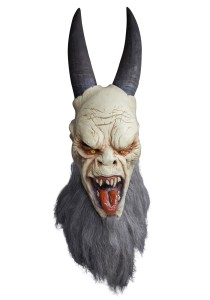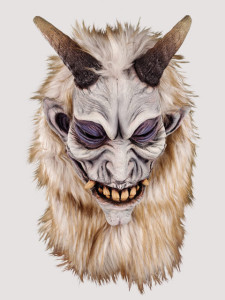
If you want a real Krampus mask from Europe, it’s possible to buy one online as discussed in a recent posting. Some our fellow American Krampuses in the Philadelphia Krampuslauf do buy European masks. They’re expensive, but at least can also serve as a nice year-round display piece. But these masks can cost several hundred dollars even without overseas shipping, so probably are more than most people want to spend.
One answer is to make one from scratch or adapt something readymade, and that’s what most of our LA Krampus Troupe members are doing. One reason for doing this is that genuine Krampus masks tend to be fairly oversized, and this ads a lot to the creature’s imposing presence. Building up the size or height of a mask, elongating the dome of the head or adding towering horns adds hugely to the creature’s imposing presence.
Luckily there are some cheaper readymade masks American masks that do a good job standing in for their European counterparts (or an excellent job with some further modifications discussed below).
But before shopping for your mask….
Have a look at what European Krampus masks really look like by doing an image search for “Krampusmasken.” They’re actually quite diverse, and rarely conform to that very standardized devil featured on the popular Krampus postcards. On the costumes — as in the photo above –you’ll notice multiple horns and more exaggerated beastly features and an wildly expressionistic cartoonish quality — note the tooth piercing the creature’s upper lip on the European mask above!
But a devil mask is not a bad starting point, and you’ll find a number of acceptable possibilities in the $20-40 range.
It may then occur to you to simply do a shopping search for “Krampus mask,” and lo, and behold, you will find a very good lookalike for around $59, a fraction of the cost of European masks. This mask was crafted by Devil’s Workshop, and began mass production in 2011. Search a little more, and you’ll find it again and again and again. Even Wallmart is now selling that mask.You can buy the exact same mask for a little more on eBay if Wallmart makes you feek icky. But you’re still likely to meet lookalike Krampuses who know your secret shame. You could always customize your mask with color — greasepaint (messy) or acrylic paint (flakey if it’s layered too thick), but even there, you may not be sporting a unique look.
If you want to class it up a bit, there is also a very nice purpose-made American Krampus mask for $85 at Specter Studio. Or another cheaper horned option is the $35-55 goat mask, which is also bound to be popular, though isn’t a great match for Krampus.
One way to open up the options a bit is to consider adding horns to a mask that doesn’t have horns. Those adhesive prosthetic Satyr horns, which are sure to be a popular choice for the “Krampus-lite” crowd this year can be spirit-gummed to a rubber mask as well as you fleshy forehead. Or a better — poke a pair of those rigid horns that come on a headband through a hornless mask of your choosing. Some options for hornless base would be an Orc or Goblin, Gargoyle, or just a search for “horned, mask.” Don’t forget to check out Specter Studio’s and Devil’s Workshop’s non-Krampus masks, as they have some cheaper models that might also do nicely once you add horns.
Also, with almost all of these masks you’d probably want to supply your own wig, to match or harmonize with whatever fur you end up adding to your body.
Werewolves can also sometimes be a decent match, and of course they are often sold with a readymade fur suit. No, it’s not really the same kind of fur suit you’ll find on European Krampuses, but it’s a start, and we’ll be posting later about dressing one of those up a bit (and other furry body-covering options). Even if you’re happy with the werewolf fursuit as-is, you might want to consider some of those other Krampus accesories: switches, bell belts, and baskets for naughty children. We’ll get to those too.



how can I get one